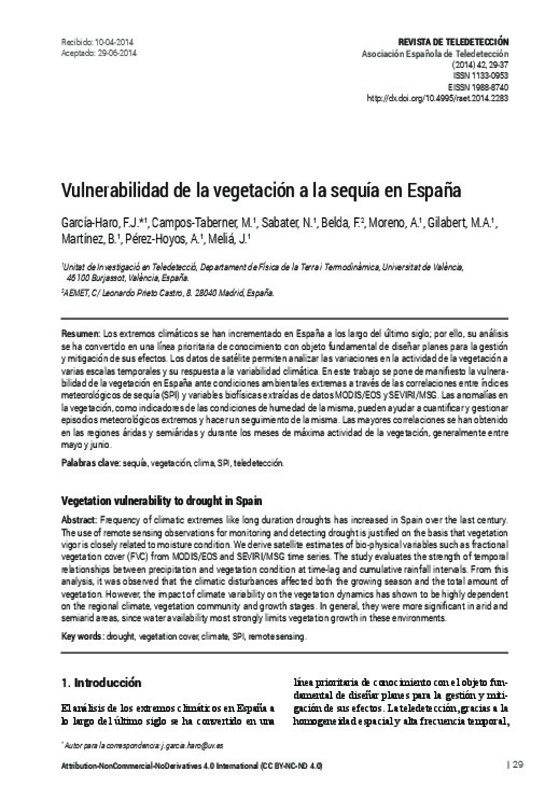JavaScript is disabled for your browser. Some features of this site may not work without it.
Buscar en RiuNet
Listar
Mi cuenta
Estadísticas
Ayuda RiuNet
Admin. UPV
Vulnerabilidad de la vegetación a la sequía en España
Mostrar el registro sencillo del ítem
Ficheros en el ítem
| dc.contributor.author | García-Haro, F.J.
|
es_ES |
| dc.contributor.author | Campos-Taberner, M.
|
es_ES |
| dc.contributor.author | Sabater, N.
|
es_ES |
| dc.contributor.author | Belda, F.
|
es_ES |
| dc.contributor.author | Moreno, A.
|
es_ES |
| dc.contributor.author | Gilabert, M.A.
|
es_ES |
| dc.contributor.author | Martínez, B.
|
es_ES |
| dc.contributor.author | Pérez-Hoyos, A.
|
es_ES |
| dc.contributor.author | Meliá, J.
|
es_ES |
| dc.date.accessioned | 2017-04-28T06:45:09Z | |
| dc.date.available | 2017-04-28T06:45:09Z | |
| dc.date.issued | 2014-12-16 | |
| dc.identifier.issn | 1133-0953 | |
| dc.identifier.uri | http://hdl.handle.net/10251/80175 | |
| dc.description | Revista oficial de la Asociación Española de Teledetección | |
| dc.description.abstract | [EN] Frequency of climatic extremes like long duration droughts has increased in Spain over the last century.The use of remote sensing observations for monitoring and detecting drought is justified on the basis that vegetation vigor is closely related to moisture condition. We derive satellite estimates of bio-physical variables such as fractional vegetation cover (FVC) from MODIS/EOS and SEVIRI/MSG time series. The study evaluates the strength of temporal relationships between precipitation and vegetation condition at time-lag and cumulative rainfall intervals. From this analysis, it was observed that the climatic disturbances affected both the growing season and the total amount of vegetation. However, the impact of climate variability on the vegetation dynamics has shown to be highly dependent on the regional climate, vegetation community and growth stages. In general, they were more significant in arid and semiarid areas, since water availability most strongly limits vegetation growth in these environments. | es_ES |
| dc.description.abstract | [EN] Los extremos climáticos se han incrementado en España a los largo del último siglo; por ello, su análisis se ha convertido en una línea prioritaria de conocimiento con objeto fundamental de diseñar planes para la gestión y mitigación de sus efectos. Los datos de satélite permiten analizar las variaciones en la actividad de la vegetación a varias escalas temporales y su respuesta a la variabilidad climática. En este trabajo se pone de manifiesto la vulnera-bilidad de la vegetación en España ante condiciones ambientales extremas a través de las correlaciones entre índices meteorológicos de sequía (SPI) y variables biofísicas extraídas de datos MODIS/EOS y SEVIRI/MSG. Las anomalías en la vegetación, como indicadores de las condiciones de humedad de la misma, pueden ayudar a cuantificar y gestionar episodios meteorológicos extremos y hacer un seguimiento de la misma. Las mayores correlaciones se han obtenido en las regiones áridas y semiáridas y durante los meses de máxima actividad de la vegetación, generalmente entre mayo y junio. | es_ES |
| dc.description.sponsorship | Este trabajo se enmarca en los proyectos DULCINEA (CGL2005–04202), RESET CLIMATE (CGL2012–35831), LSA SAF (EUMETSAT) y ERMES (FP7-SPACE-2013, Contract 606983). | |
| dc.language | Español | es_ES |
| dc.publisher | Universitat Politècnica de València | |
| dc.relation.ispartof | Revista de Teledetección | |
| dc.rights | Reconocimiento - No comercial - Sin obra derivada (by-nc-nd) | es_ES |
| dc.subject | Sequía | es_ES |
| dc.subject | Vegetación | es_ES |
| dc.subject | Clima | es_ES |
| dc.subject | SPI | es_ES |
| dc.subject | Teledetección | es_ES |
| dc.subject | Drought | es_ES |
| dc.subject | Vegetation cover | es_ES |
| dc.subject | Climate | es_ES |
| dc.subject | Remote sensing | es_ES |
| dc.title | Vulnerabilidad de la vegetación a la sequía en España | es_ES |
| dc.title.alternative | Vegetation vulnerability to drought in Spain | es_ES |
| dc.type | Artículo | es_ES |
| dc.date.updated | 2017-04-26T12:02:35Z | |
| dc.identifier.doi | 10.4995/raet.2014.2283 | |
| dc.relation.projectID | info:eu-repo/grantAgreement/MEC//CGL2005-04202/ES/Metodologías para caracterizar las cubiertas vegetales a partir de sensores de última generación. Cambio climático y su incidencia en la vegetación de la Península Ibérica (DULCINEA)/ | |
| dc.relation.projectID | info:eu-repo/grantAgreement/EC/FP7/606983/EU/ERMES: An Earth obseRvation Model based RicE information Service/ | |
| dc.relation.projectID | info:eu-repo/grantAgreement/MINECO//CGL2012-35831/ES/TELEDETECCION DE VARIABLES CLIMATICAS ESENCIALES: EFECTOS DEL ESTRES HIDRICO EN LA ESTIMACION DE FLUJOS DE CARBONO/ | |
| dc.rights.accessRights | Abierto | es_ES |
| dc.description.bibliographicCitation | García-Haro, F.; Campos-Taberner, M.; Sabater, N.; Belda, F.; Moreno, A.; Gilabert, M.; Martínez, B.... (2014). Vulnerabilidad de la vegetación a la sequía en España. Revista de Teledetección. (42):29-38. https://doi.org/10.4995/raet.2014.2283 | es_ES |
| dc.description.accrualMethod | SWORD | es_ES |
| dc.relation.publisherversion | https://doi.org/10.4995/raet.2014.2283 | es_ES |
| dc.description.upvformatpinicio | 29 | es_ES |
| dc.description.upvformatpfin | 38 | es_ES |
| dc.type.version | info:eu-repo/semantics/publishedVersion | es_ES |
| dc.description.issue | 42 | |
| dc.identifier.eissn | 1988-8740 | |
| dc.contributor.funder | Ministerio de Economía y Competitividad | |
| dc.contributor.funder | European Commission | |
| dc.contributor.funder | Ministerio de Educación y Ciencia | es_ES |








